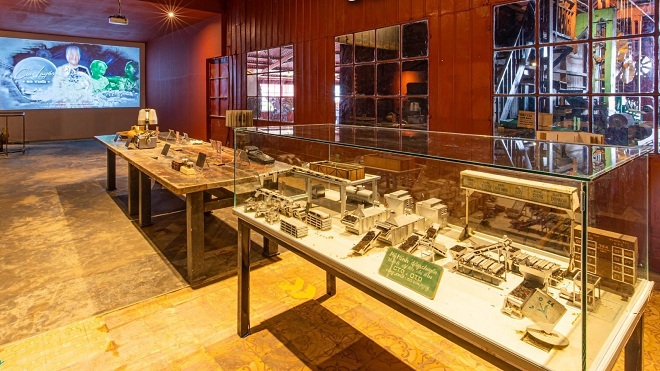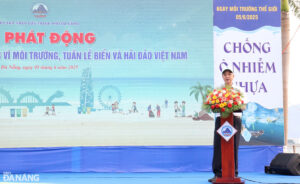More than 20 km from the centre of Da Lat City, Lam Dong province, located at an altitude of 1,650 metres above sea level, on the foundation of the ancient tea factory of Southeast Asia, the Cau Dat Farm Ancient Tea Museum is an interesting installation art space associated with the story of Cau Dat tea brand which itself it nearly 100 years old.

At Cau Dat Farm Ancient Tea Museum, Da Lat City, Lam Dong province.(Photo: caudatfarm.com)
As a famous tea area in Lam Dong province, Cau Dat is located at an ideal height with a cool climate all year round, with immense green tea hills and lush tea buds. In 1927, the French built the first tea factory in East-South Asia and named it the Cau Dat L'Arbre Broyé Tea Department; applying tea processing processed at the factory. Later, the factory was converted to its current use, and renamed Cau Dat Farm.
The entire factory area, equipment, machines, tools and tea making machines (nearly 100 years old), along with the original tea-making artifacts are all preserved to serve the idea of building the first tea museum in Vietnam. After more than three years of incubation, in early 2021, the Cau Dat Farm Ancient Tea Museum officially came into operation with the desire to preserve a part of the history of Cau Dat Tea Hill, while at the same time, recreating the ups and downs as well as the experience of making tea of the people here.
The highlight of the museum is the installation art space, utilising sound and light, making the museum an artwork, and creating a profound effect for visitors.
Visiting the museum, visitors have an opportunity to learn about tea trees through six separate spaces, each with a tea tree related content. A room named "Quintessence 1,650 metres" recreates the Cau Dat tea hill all year round, hidden in the mist, with the ups and downs of history and 100 years of tea making experience through nine large-sized videos screens on a wall. Viewers enter a room filled with the images and sounds of nature and the people of Cau Dat at the altitude of 1,650 metres.
A room named “Historical Box” showcases tea-making artifacts with a long history, including dust-coated machines such as dryers for drying tea, heat pipes of the tea drying system, ventilation fan systems, combination screening machines, and a finished tea beard vacuum cleaner. An interesting point in the museum space is the third room with the name of “1 tom 2 la” (a criterion for the evaluation of a good tea), displays installation artworks that fuse light and large-scale tea cubes, creating an auditory and tactile feel. More than 100 tea cubes ,made up of 350 kilogrammes of green tea, black tea and oolong tea are divided into three separate areas, with thousands of glittering rain yarns connecting the series of floating cloud lights to create a warm, vaguely and fanciful atmosphere, depicting the rolling hills and clouds of Cau Dat.
On the horizontal wall of the museum, there are seven paintings simulating the tea making process at Cau Dat ,reproduced in a simple and pure visual language. A special feature is how the main materials used for this series of paintings, from dyes to paints, are taken from the soil of the tea hills and tea leaves in Cau Dat Farm. Each picture is lined with hundreds of sheets of "fish" paper - a special paper made from rice that the people of the central fishing village use to preserve fish. The fourth room tells the story of tea makers with tools used in tea making in the past. Artists have used wooden doors from old tea warehouses, thereby telling the story of Cau Dat Farm tea making through the generations.
In the fifth room named "Overlooking the world of tea", visitors experience the diverse tea cultures of the world and learn more about the journey of fresh tea leaves from harvest to final product. The sixth room is the viewing space at Cau Dat Farm. Visitors will have a chance to experience cups of green tea, black tea and oolong tea made artisans, in the same way tea growers and brewers perceive tea with their senses.
Bringing art to create a living space through movies, documents, images, artifacts, Cau Dat Farm Ancient Tea Museum has recreated the history, people, tea making process as well as products of the Cau Dat tea brand. It is not only an interesting destination for visitors to visit and experience and learn about the history of development, tea making techniques and tea cultivation, the museum is also contributing to displaying and preserving the historical values of the Cau Dat tea hill.
Ngoc Lien
















